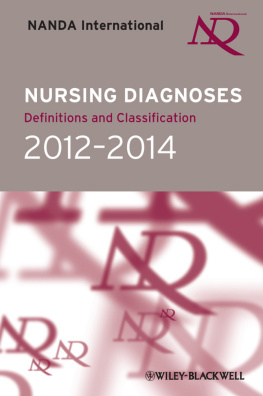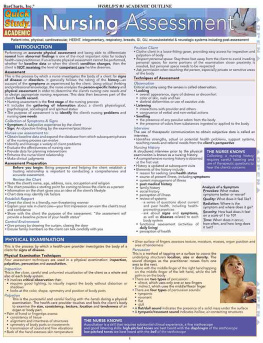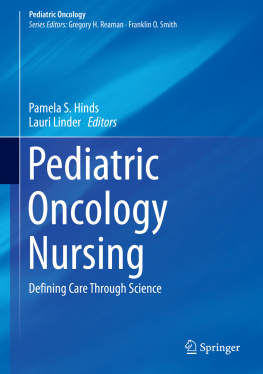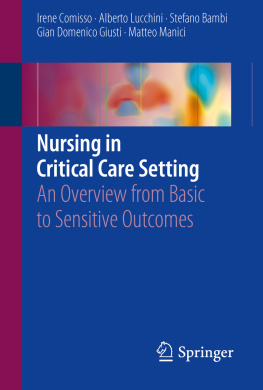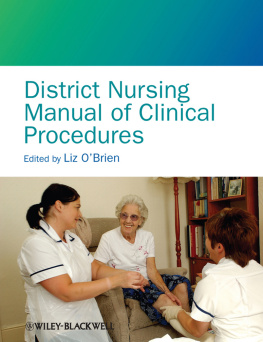This edition first published 2012
2012, 2009, 2007, 2005, 2003, 2001, 1998, 1996, 1994 by NANDA International
Wiley-Blackwell is an imprint of John Wiley & Sons, formed by the merger of Wileys global Scientific, Technical and Medical business with Blackwell Publishing.
Registered office: John Wiley & Sons, Ltd, The Atrium, Southern Gate, Chichester, West Sussex, PO19 8SQ, UK
Editorial offices: 9600 Garsington Road, Oxford, OX4 2DQ, UK
The Atrium, Southern Gate, Chichester, West Sussex, PO19 8SQ, UK
2121 State Avenue, Ames, Iowa 50014-8300, USA
For details of our global editorial offices, for customer services and for information about how to apply for permission to reuse the copyright material in this book please see our website at www.wiley.com/wiley-blackwell.
The right of the author to be identified as the author of this work has been asserted in accordance with the UK Copyright, Designs and Patents Act 1988.
All rights reserved. No part of this publication may be reproduced, stored in a retrieval system, or transmitted, in any form or by any means, electronic, mechanical, photocopying, recording or otherwise, except as permitted by the UK Copyright, Designs and Patents Act 1988, without the prior permission of the publisher.
Designations used by companies to distinguish their products are often claimed as trademarks. All brand names and product names used in this book are trade names, service marks, trademarks or registered trademarks of their respective owners. The publisher is not associated with any product or vendor mentioned in this book. This publication is designed to provide accurate and authoritative information in regard to the subject matter covered. It is sold on the understanding that the publisher is not engaged in rendering professional services. If professional advice or other expert assistance is required, the services of a competent professional should be sought.
ISBN 9780470654828
ISSN 1943-0728
A catalogue record for this book is available from the British Library.
This book is published in the following electronic formats: ePDF 9781119979302; ePub 9781119979319; Mobi 9781119979326
NANDA International Guidelines for Copyright Permission
The materials presented in this book are copyrighted and all copyright laws apply.
For any usage other than reading or consulting the book in the English language, a licence is required from Blackwell Publishing Ltd (a company of John Wiley & Sons Inc).
Examples of such reuse include, but are not restricted to:
A publishing house, other organization, or individual wishing to translate the entire book, or parts thereof.
An author or publishing house wishing to use the entire nursing diagnosis taxonomy, or parts thereof, in a commercially available textbook or nursing manual.
An author or company wishing to use the nursing diagnosis taxonomy in audiovisual materials.
A software developer or computer-based patient record vendor wishing to use the nursing diagnosis taxonomy in English in a software program or application (for example, an electronic health record or an electronic application for a smart phone/personal digital assistant [PDA]).
A nursing school, researcher, professional organization, or healthcare organization wishing to use the nursing diagnosis taxonomy in an educational program.
A hospital wishing to integrate the nursing diagnosis taxonomy into their own electronic health records.
Any of the usages outlined above in a language other than English.
Please send all requests by e-mail to: , or by post to:
NANDA International Copyright Requests
Global Rights Department
John Wiley & Sons Ltd.
The Atrium
Southern Gate
Chichester
West Sussex
PO19 8SQ
UK
Translations Terms and Conditions
The full terms and conditions for translations will be as follows (this includes those already agreed and implemented for the current edition):
- There will be no buy-back by Wiley-Blackwell or NANDA-I of unsold copies of any translations at the time that the next edition is released.
- Publishers cannot add or remove any content from the original version provided by Wiley-Blackwell. This includes the addition of forwards, new prefaces or comments by translators or other parties. The only exception to this is the addition, under the name of the editor, of the translators of each version, who should be identified as translators (not as authors or editors).
- We will require publishers to submit the name, qualifications and rsum of the chief translator for approval prior to commencing any translation work.
- Publishers must also submit both the cover design and the manuscript of the translation to Wiley-Blackwell for approval by NANDA-I prior to printing the translation. NANDA-I requires up to 12 weeks to complete this approval process, so it should be built into your production schedule.
- Any and all changes requested by NANDA-I must be included in the translation, and publishers shall be required to submit page proofs for a final check before printing the translation.
- Publishers will be required to include an advertisement for NANDA-I membership in the translation.
- Publishers will be expected to allow digital licensees, predominantly software developers, to use their translation in their products upon a mutually agreed fee. To this end, the following Clause will be included in all translation licenses:
The Proprietor licenses the exclusive rights specified in clause 1 (a) (i) to the Publisher on the condition that the Publisher shall provide electronic files of the Translation to any third parties who have entered into a valid digital licence agreement with the Proprietor (Digital Products Licensees), following notification from the Proprietor of such licences. The electronic files provided by the Publisher to the Digital Products Licensees will be for use only in digital products such as software applications, smart phone applications, online learning courses and other digital products now existing or to be invented in the future (Digital Products) solely in the Territory, but for the avoidance of doubt shall not include e-books (unabridged verbatim electronic copies of the print Translation). The Publisher may charge a reasonable fee for providing the electronic files to the above-mentioned Digital Products Licensees, such fee to be retained in full by the Publisher. The Proprietors Digital Products Licensees shall credit the Publisher as the publisher of the Translation, and shall cooperate with the Publisher to promote the print Translation in all Digital Products made available in the Territory. It is understood and agreed that the Publisher shall have the first option to license the right to publish the Translation in e-book format, on terms to be agreed.
Preface
The 20122014 edition of NANDA Internationals classic text Nursing Diagnoses: Definitions & Classification builds on the success of the well-received new look and feel of the 20092011 edition. This latest edition includes 16 new and 11 revised diagnoses together with several new or refreshed opening chapters. These essays in best practice in the development, testing, and use of Nursing Diagnoses have been written by some of the most accomplished scholars in the field, and I commend them to you. The aim of including these outstanding contributions is to ensure that we all use Nursing Diagnoses safely and consistently in our practice worldwide.
NANDA International is a not-for-profit membership organization. This means that, with the exception of our business management and administration functions, all of our work is done by volunteers. Indeed, some of the worlds most talented nurse scientists and scholars are or have been NANDA International volunteers. So, contrary to popular belief, there is not an office block somewhere in the United States with rows of nurse researchers working on Nursing Diagnoses. Our volunteers are people like you and me who give their time and expertise to NANDA International because of their strongly held beliefs about the primacy of patient care and the contribution that nursing and nurses can make.

